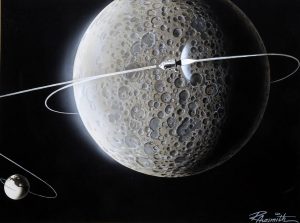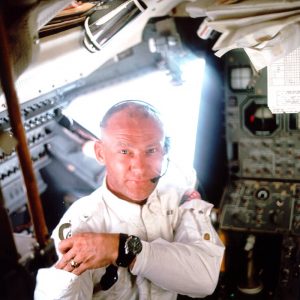In order to gain some knowledge of the subjects I will be covering in this project, I decided to conduct some research on the Apollo 11 mission, as well as the meaning and cause behind it, and how it impacted NASA.
I used a variety of websites to gather this research, which I will list at the bottom of this page.
The Space Race between the United States (US) and the Soviet Union (USSR) was a remarkable time in history with many far-reaching achievements in science, space exploration, and technology. This timeline shows the twenty-year competition between the two nations.
2 August 1955: The USSR responds to the US announcement that they intend to launch the first artificial satellite into space with a satellite of their own.
4 October 1957: The USSR successfully launches Sputnik 1, the first Earth-orbiting satellite in history.
3 November 1957: The USSR successfully launches Sputnik 2, carrying a dog named Laika into space. They become the first nation to successfully send a living organism into orbit.
31 January 1958: The US enter the Space Race by launching Explorer 1, the first US satellite to reach orbit. It carried experimental equipment that led to the discovery of the Van Allen radiation belt.
1 October 1958: The National Aeronautics and Space Administration (NASA) is created in the US, replacing the National Advisory Committee on Aeronautics (NACA).
18 December 1958: The US launch SCORE, the world’s first communications satellite. It captured world attention by broadcasting a pre-recorded Christmas message from US President Dwight D. Eisenhower, becoming the first broadcast of a human voice from space.
2 January 1959: The USSR launches Luna 1, known as the first “cosmic rocket” as it accidentally escaped the orbit of the Moon due to the object having too much speed. Luna 1 becomes the first human-made object to leave the orbit of the Earth and orbit the sun instead.
2 August 1959: The US launches Explorer 6, the world’s first weather satellite and obtains the first pictures of Earth from space.
12 September 1959: The USSR launches Luna 2 and accomplishes its mission of creating the first spacecraft to reach the surface of the Moon.
4 October 1959: The USSR launches Luna 3 and succeeds in their mission of sending an object into orbit around the Moon and photographing the far side of the Moon.
19 August 1960: Aboard the Soviet Union’s Sputnik 5, the first animals (two dogs, Belka and Strelka) and a range of plants are returned alive from space.
31 January 1961: Ham, a US chimpanzee, becomes the first hominid (or great ape) in space and the first to successfully survive the landing.
12 April 1961: The Soviet Union achieve a clear triumph in the Space Race. Aboard the Vostok 1, Yuri Gagarin makes a single orbit around the Earth and becomes the first man to reach space. He remained in space for one hour and forty-eight minutes before landing in Saratov Oblast, west Russia.
5 May 1961: The US achieve the first pilot-controlled journey and first American in space with Alan Shepard aboard the Mercury-Redstone 3 (or Freedom 7) spacecraft. On this flight, Shepard did not orbit Earth. He flew 116 miles high. The flight lasted about 15 minutes.
16 June 1963: Valentina Tereshkova becomes the first civilian and first woman in space. She spends almost three days in space, orbiting the Earth 48 times aboard her spacecraft, Vostok 6.
18 March 1965: Alexei Leonov leaves his spacecraft, the Voskhod 2, in a specialized spacesuit and conducts a twelve-minute spacewalk, the first of its kind.
14 July 1965: The US satellite, Mariner 4, performs the first successful voyage to the planet Mars, returning the first close-up images of the Martian surface.
1967: This year proves the most deadly of the Space Race for both the US and Soviet Union. In January, American astronauts Ed White, Gus Grissom, and Roger Chaffee die when a fire ignited in their Apollo 1 capsule on the launch pad. Only a few months later the Soviet cosmonaut Vladimir Komarov is also killed when the parachute on his Soyuz 1 capsule fails to open on his reentry into Earth’s atmosphere.
21 December 1968: US spacecraft Apollo 8 becomes the first human-crewed spacecraft to reach the Moon, orbit it, and successfully return to Earth.
20 July 1969: Neil Armstrong and later Edwin “Buzz” Aldrin become the first men to walk on the Moon while their crewmate Michael Collins continues to orbit the Moon aboard the Apollo 11. This secured a victory for America in the Space Race with a televised landing witnessed around the world by 723 million people.
What was the Space Race?
The Space Race was a 20th Century struggle between two nation-states, the Soviet Union (USSR) and the United States (US). The pursuit for both was the domination of space flight technologies. The competition began on 2 August 1955, when the Soviet Union responded to the US announcement of their similar intent to launch artificial satellites.
The Space Race has its origins in the nuclear arms race between the two nations following the Second World War. Both sides were aided by German missile technology and scientists from their missile programme. The technological advantages required for such power were seen as necessary for national security and political superiority. The Space Race produced groundbreaking efforts to launch artificial satellites; space probes of the Moon, Venus, and Mars, and human space voyages in low Earth orbit and lunar missions.
Mission Objective
The primary objective of Apollo 11 was to complete a national goal set by President John F. Kennedy on May 25, 1961: perform a crewed lunar landing and return to Earth.
Additional flight objectives included scientific exploration by the lunar module, or LM, crew; deployment of a television camera to transmit signals to Earth; and deployment of a solar wind composition experiment, seismic experiment package and a Laser Ranging Retroreflector. During the exploration, the two astronauts were to gather samples of lunar-surface materials for return to Earth. They also were to extensively photograph the lunar terrain, the deployed scientific equipment, the LM spacecraft, and each other, both with still and motion picture cameras. This was to be the last Apollo mission to fly a “free-return” trajectory, which would enable a return to Earth with no engine firing, providing a ready abort of the mission at any time prior to lunar orbit insertion.
Crew
Neil Armstrong, Commander
Edwin E. “Buzz” Aldrin Jr., Lunar Module Pilot
Michael Collins, Command Module Pilot
Backup Crew
James A. Lovell, Commander
Fred W. Haise Jr., Lunar Module Pilot
William A. Anders, Command Module Pilot
Launch
July 16, 1969; 9:32 a.m. EDT
Launch Pad 39A
Saturn-V AS-506
High Bay 1
Mobile Launcher Platform-1
Firing Room 1
Orbit
Altitude: 118.65 miles
Inclination: 32.521 degrees
Orbits: 30 revolutions
Duration: eight days, three hours, 18 min, 35 seconds
Distance: 953,054 miles
Lunar Location: Sea of Tranquility
Lunar Coordinates: .71 degrees north, 23.63 degrees east
Landing
July 24, 1969; 12:50 p.m. EDT
Pacific Ocean
Recovery Ship: USS Hornet
Images
Along with research about the mission, I have compiled a collection of images which can be useful towards the development of my project.




























Websites Used:
- https://www.lpi.usra.edu/lunar/missions/apollo/apollo_11/
- https://www.bbc.com/future/article/20190715-the-most-beautiful-photos-taken-on-the-apollo-11-mission
- https://www.britannica.com/topic/Apollo-11
- https://www.space.com/space-race.html
- https://www.history.com/topics/cold-war/space-race
- https://www.esa.int/About_Us/ESA_history/The_Apollo_11_crew#:~:text=The%20Apollo%2011%20crew%20is,both%20US%20Air%20Force%20pilots.
- https://www.express.co.uk/news/science/1154150/moon-landing-quotes-one-small-step-memorable-nasa-apollo-11-moon-landing-speech-space-news